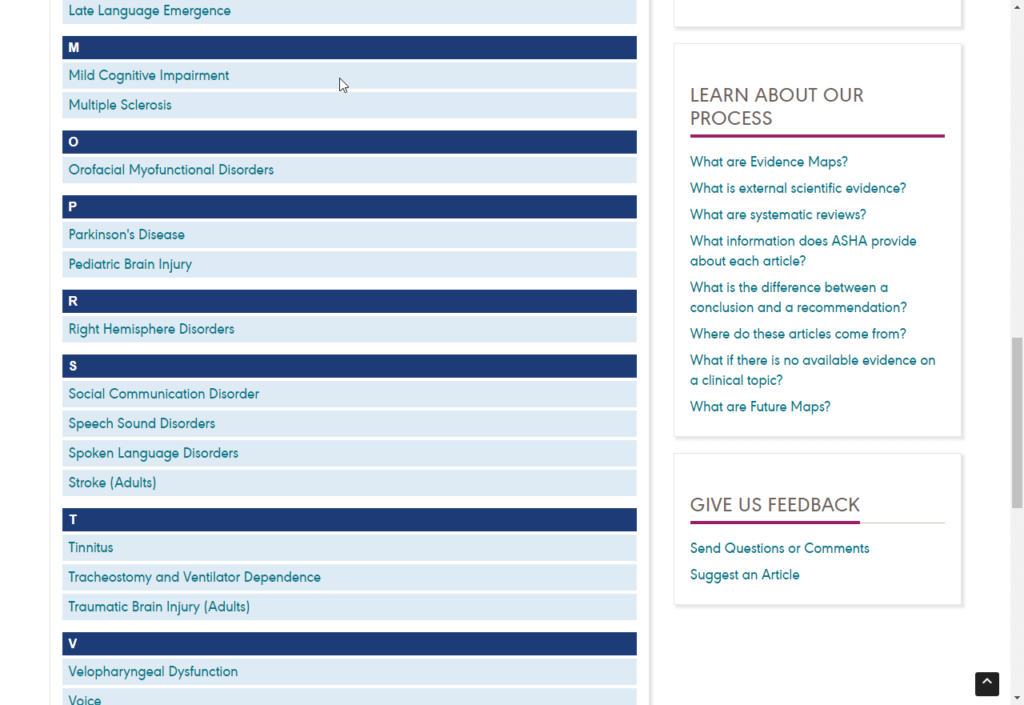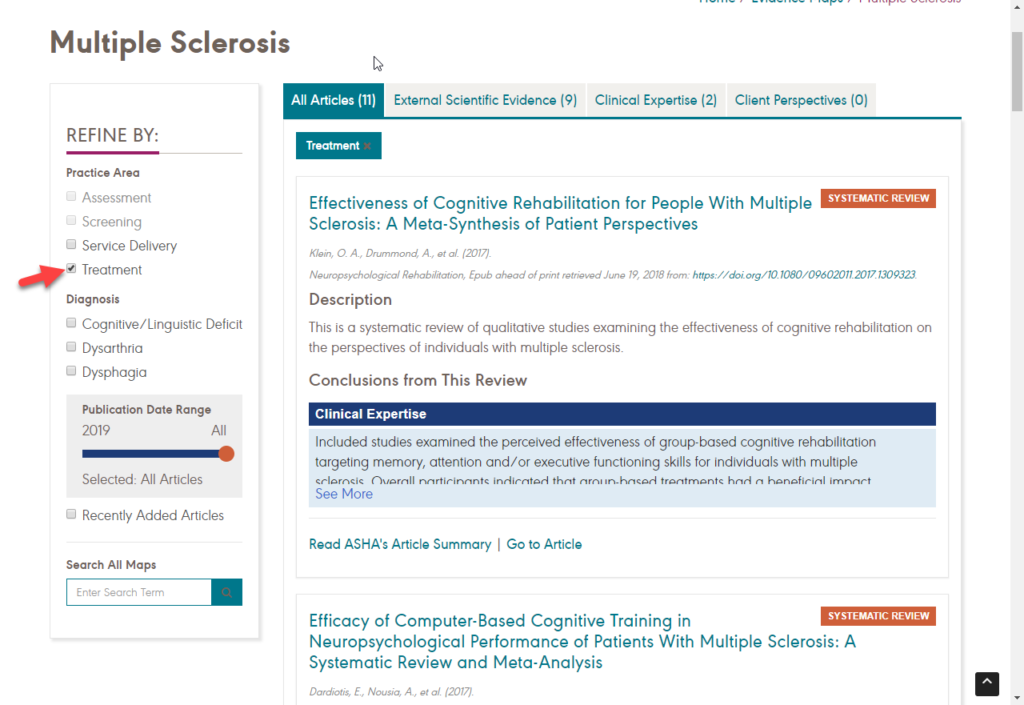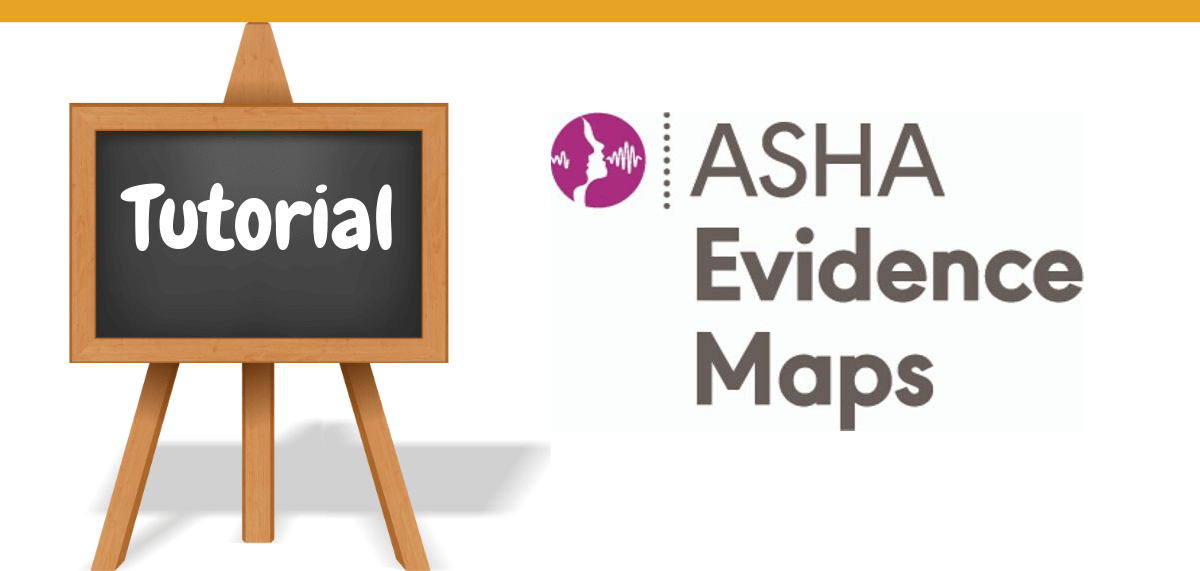Don’t get lost in the sea of information, research, and opinion! Use ASHA’s Evidence Maps to quickly find evidence relevant to your patients. Read about my experience trying the maps out with my caseload.
Free DIRECT download: ASHA’s Evidence Maps (cheat sheet). (Email subscribers get free access to all the resources in the Free Subscription Library.)
Outline:
- The angst of EBP.
- How ASHA saves you time and energy.
- Searching the evidence on behalf of Mrs. Jones.
- Try using the maps for one of your patients.
- Guest contributor bio.
- Related Eat, Speak, Think posts.
The angst of EBP
Lack of time, opportunity,or skill in using the evidence
As speech-language pathologists (SLPs), we all know we’re supposed to use evidence-based practice (EBP) to guide clinical decision-making and ensure the best possible outcomes for our patients. However, searching, finding, evaluating, and using evidence can be very time-consuming.
For many of us, the gap between the countless hours we spent researching and planning for one client in the university clinic and the little to no planning time in our work setting feels too big to overcome.
How do we find the time to research evidence-based information when we don’t have enough time to do the million and one other things we have to do? Where can we access articles? And once we have them, how do we use them?
And while we can use social media to find some direction, there’s a sense of pressure to use EBP to defend every statement or suggestion we make. As licensed and certified SLPs, it can be hard to admit to ourselves or others that we don’t know as much as we feel we should. This is called imposter syndrome.
Feeling and dealing with imposter syndrome
Imagine you have a new patient on your caseload with either a diagnosis or a deficit that you don’t work with often. When you go to create your plan of care, you don’t feel very confident in your goals and interventions. You have a nagging feeling that what you’re doing may not be the “right” thing. You feel like you’re in your Clinical Fellowship all over again.
Unfortunately, that imposter syndrome feeling doesn’t go away the moment you’re granted your CCCs, and even the very best clinicians don’t automatically know what to do with every single patient they treat.
That’s where research comes in. And using ASHA’s Evidence Maps can point you in the right direction in minutes.
How ASHA saves you time and energy
ASHA understands that as a busy clinician, it can be hard to find time to go to the bathroom and grab a bite to eat, let alone spend hours combing through hundreds of articles to find the latest, high-quality research related to your specific patient and their unique characteristics and challenges.
The long, slow path to finding relevant evidence
As an example, let’s consider Mrs. Jones, our new patient with multiple sclerosis (MS). She’s having memory difficulty that’s beginning to impact her daily life.
At this point, we could turn to social media groups (“Is that treatment even effective? Is there any evidence behind it?), Google searches (“These articles are for patients or doctors. Is there anything here related to SLPs?”), or outdated resources (“I think I still have my grad school notes in a box in the attic.”).
But this leads to a lot of work and uncertainty.
Research, or opinions masquerading as research, is everywhere – news, social medial, podcasts, magazines, journals, radio, and webinars. Having access to so much information makes it hard to find recent, high-quality information that’s applicable to our patient.
Perhaps we come across articles about the best medications to treat MS, cognitive impairments following TBI, learning disabilities tied to working memory challenges, or energy conservation strategies for patients with MS.
Now we’ve spent considerable time sifting through information that may be interesting, but has little to do with Mrs. Jones. We’re not any closer to finding appropriate interventions to address memory loss in our patient. We could keep searching and/or reach out on social media, or we could head over to ASHA’s Evidence Maps.
ASHA’s Evidence Maps: The fast way to find relevant evidence
ASHA has a dedicated staff in the National Center for Evidence-Based Practice (N-CEP) who have done much of the legwork for you by creating the ASHA Evidence Maps. The N-CEP staff has done the first few rounds of sifting for you so you can pay attention to the few pieces of synthesized literature that relate to your clinical question.
The Evidence Maps contain the latest articles that address clinical topics in speech-language pathology and audiology. The Maps organize systematic reviews, meta-analyses, clinical practice guidelines, and ASHA practice policies according to clinical topic to make the articles you need easy to find.
The articles are also appraised for quality so you can determine if its conclusions are trustworthy. Finally, the conclusions of each article are summarized so you can determine at a glance if the article is relevant to your patient.
The Evidence Maps serve as a guide to lead you to what you’re looking for quickly and easily, either through filtering or keyword search. When the literature is already appraised, summarized, and categorized for you, you save your most precious resource: time.
Searching the evidence on behalf of Mrs. Jones
Step 1: Select “Multiple Sclerosis”
When you open the Evidence Maps, you’ll see a list of 40+ diagnoses and/or clinical topics. Scroll down to “M” for Multiple Sclerosis.

Step 2: Select treatment.
Next, look at the practice area and select whether you’re interested in assessment, screening, service delivery, or treatment. For our example patient Mrs. Jones, we’re interested strictly in treatment.

Now we’re down to 11 articles that address SLP/Audiology treatment in patients with MS.
Step 3: Select cognitive/linguistic deficits.
To further refine our search, we select cognitive/linguistic deficits, which returns eight articles.

Or, simply use the search bar
Alternatively, we can use the search bar in the top right corner on the Evidence Maps page. By typing in “memory treatment multiple sclerosis”, we’re able to access the same eight articles as above.

If we’re unable to find what we need via the search bar, we can filter by diagnosis/topic, etc.
Step 4: Scan and select relevant information
After a few quick clicks or a simple search, we’re now looking at eight articles related to the treatment of cognitive-linguistic deficits in individuals with MS. These articles have already been appraised for quality and summarized. With a quick scan, we can determine if they apply to our patient.
A process that could have taken hours of Google and database searching and sifting takes less than five minutes when we know where to look. That’s the value of the maps. It tells us where to go so we don’t spend hours wandering around lost in a sea of information that has no application to our clinical question.
Now, armed with the latest synthesized research, we can use our clinical expertise to work with our client to make an effective and relevant treatment plan.
Try using the maps for one of your patients
Now that you’ve seen how easy it is to use ASHA’s evidence maps, give it a try for one of your patients. If you have questions, check out ASHA’s Evidence Maps video tutorial series or contact me at the address below.
Free DIRECT download: ASHA’s Evidence Maps (cheat sheet). (Email subscribers get free access to all the resources in the Free Subscription Library.)
Related Eat, Speak, & Think posts
- Applying ASHA’s Evidence Maps to my caseload.
- 40+ places to find ASHA CEUs.
- Collaborative goal-setting to identify meaningful cognitive goals.
Guest contributor bio
Rebecca Bowen, M.A, CCC-SLP is a speech-language pathologist and clinical research associate in ASHA’s National Center for Evidence-Based Practice. She has a variety of clinical experience including hospital, outpatient, and home health settings. She can be reached at rbowen@asha.org.


[…] https://eatspeakthink.com/asha-evidence-maps-save-time […]